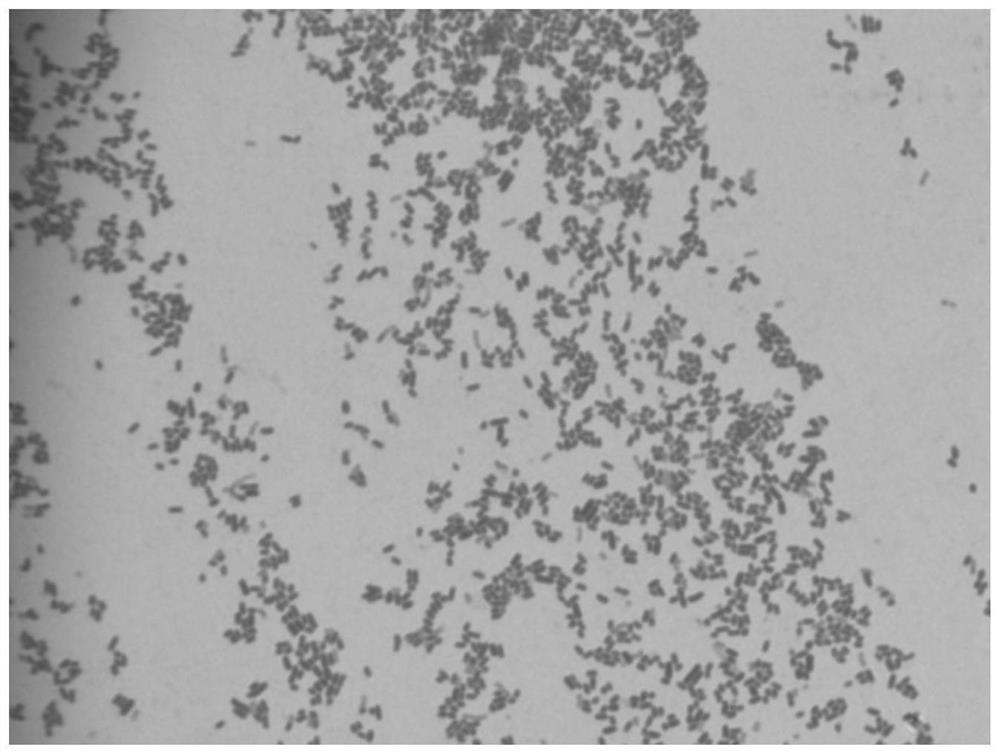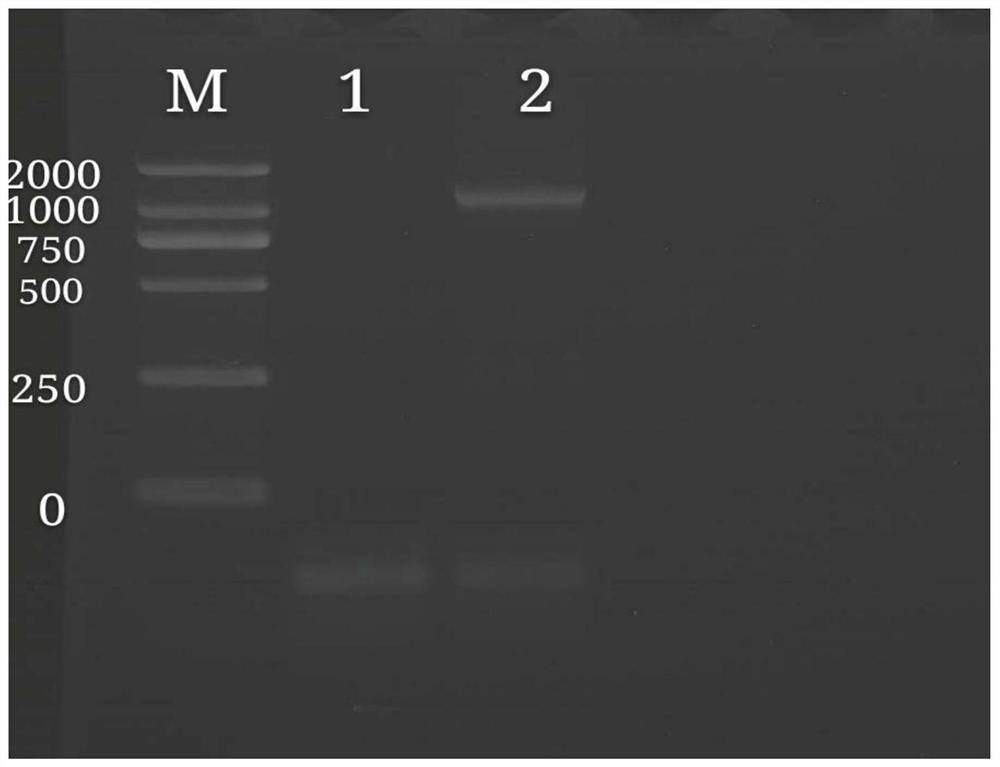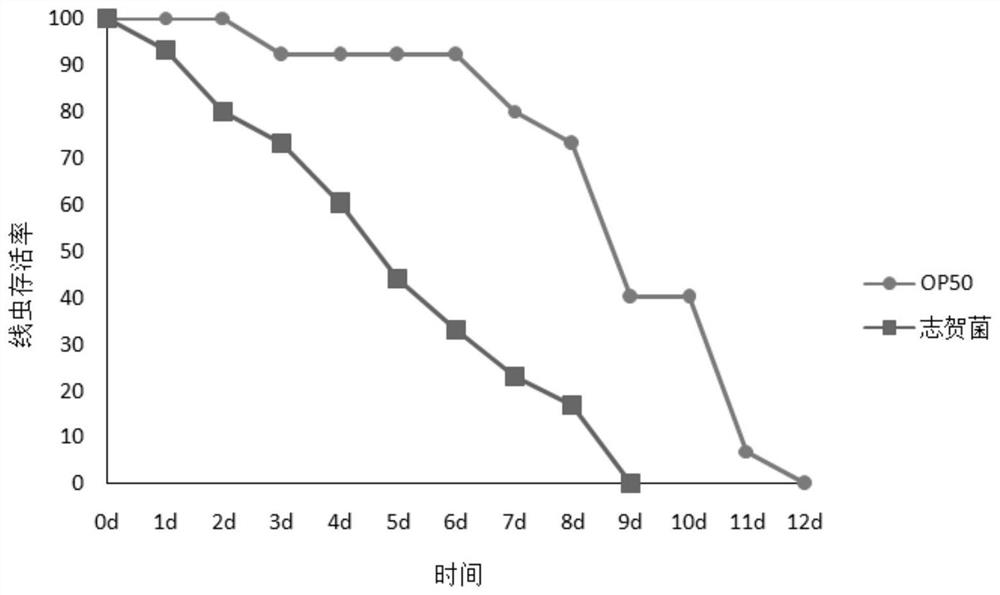Method for rapidly detecting bovine-derived shigella virulence by using defective caenorhabditis elegans
A technology of Caenorhabditis elegans and Shigella, applied in biochemical equipment and methods, preparations for in vivo experiments, measuring devices, etc., to save time and cost, reduce damage, and have broad application prospects
- Summary
- Abstract
- Description
- Claims
- Application Information
AI Technical Summary
Problems solved by technology
Method used
Image
Examples
Embodiment 1
[0032] The processing of embodiment 1 Shigella
[0033] 1. Isolation and identification of bacteria: Bacteria isolated from bovine intestines in vitro were inoculated on MacConkey solid medium, and a colorless colony was isolated. Pick a single colony for Gram staining, microscopic examination, and inoculate on MacConkey medium, culture at 37°C for 16-18 hours, further purify and inoculate in LB liquid medium for re-cultivation.
[0034] 2. Bacterial DNA extraction: Fish the purified bacteria with a sterile inoculation loop, inoculate into MacConkey solid medium, incubate at 37°C for 16-18h, pick a single colony into LB broth, incubate at 37°C for 18h, follow Bacterial DNA Extraction Kit steps to extract DNA.
[0035] 3. PCR (polymerase chain reaction): use the extracted DNA as a template to amplify the 16S rRNA gene fragment, and the primer sequences are as follows:
[0036] 27F: 5'-AGAGTTTGATCMTGGCTCAG-3' (SEQ ID NO: 1);
[0037] 1492R:5'-GGCTACCTTGTTACGACTT-3' (SEQ ID NO...
Embodiment 2
[0044] Embodiment 2 nematode pathogenicity test
[0045] 1. Simultaneous treatment of Caenorhabditis elegans: Select an NGM plate with many adults and eggs and no mold contamination, and wash it repeatedly with M9 buffer to wash the nematodes and eggs from the OP50 bacterial lawn, and collect the sterilized plate. In a 15mL centrifuge tube, add M9 buffer solution to 10mL, centrifuge at 3000r / min for 1min, discard the supernatant, add 1mL nematode lysate, and vortex for 4min (the lysis time should not be too long, so as not to kill the eggs) , centrifuge at 3000r / min for 1min, and discard the supernatant. Add M9 buffer to make up to 10mL, centrifuge at 3000r / min for 1min, and repeat washing 3 times to remove the lysate. Finally, S basic solution was added to make the volume to 10 mL, and placed in a shaker at 20 °C and 150 r / min for 20 h. Then centrifuge at 3000r / min for 1min, discard the supernatant, transfer the L1 stage nematodes at the bottom of the centrifuge tube to a c...
Embodiment 3
[0052] Simultaneous treatment of Caenorhabditis elegans: Select an NGM plate with more adults and eggs and no mold contamination, wash it repeatedly with M9 buffer, wash the nematodes and eggs from the OP50 bacterial lawn, and collect them in a sterilized 15mL centrifuge In the tube, add M9 buffer solution to 10mL, centrifuge at 3000r / min for 1min, discard the supernatant, add 1mL of nematode lysate, vortex for 4min (the lysis time should not be too long, so as not to kill the eggs), 3000r Centrifuge for 1 min, and discard the supernatant. Add M9 buffer to make up to 10mL, centrifuge at 3000r / min for 1min, and repeat washing 3 times to remove the lysate. Finally, S basic solution was added to make the volume to 10 mL, and placed in a shaker at 20°C and 140 r / min for 22 hours. Then centrifuge at 1500r / min for 3min, discard the supernatant, transfer the L1 stage nematodes at the bottom of the centrifuge tube to a clean NGM plate, and place them in a biochemical incubator at 20°...
PUM
 Login to View More
Login to View More Abstract
Description
Claims
Application Information
 Login to View More
Login to View More - R&D
- Intellectual Property
- Life Sciences
- Materials
- Tech Scout
- Unparalleled Data Quality
- Higher Quality Content
- 60% Fewer Hallucinations
Browse by: Latest US Patents, China's latest patents, Technical Efficacy Thesaurus, Application Domain, Technology Topic, Popular Technical Reports.
© 2025 PatSnap. All rights reserved.Legal|Privacy policy|Modern Slavery Act Transparency Statement|Sitemap|About US| Contact US: help@patsnap.com



